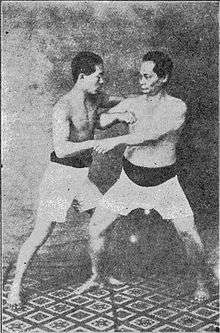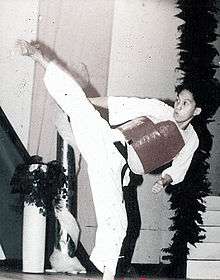Kumite

Kumite (組手) literally translated means "grappling hands" and is one of the three main sections of karate training, along with kata and kihon. Kumite is the part of karate in which a person trains against an adversary, using the techniques learned from the kihon and kata.
Kumite can be used to develop a particular technique or a skill (e.g. effectively judging and adjusting one's distance from one's opponent) or it can be done in competition.
Gohon Kumite and Jiyu Kumite
Since the word "kumite" refers to forms of sparring, it covers a vast range of activities. In traditional Shotokan karate, the first type of kumite for beginners is gohon kumite. The defender steps back each time, blocking the attacks and performing a counterattack after the last block. This activity looks nothing like the jiyu kumite (or "free sparring") practiced by more advanced practitioners, which is far closer to how karate would look if used in a real fight, especially because it is not choreographed. Karate and other forms of martial arts have various other types of kumite (e.g. 3-step, 1-step, semi-free, etc.) which span this large range in
Types of Kumite
- Gohon kumite - five-step sparring, pre-arranged attack and counter exercise for beginners
- Ippon kumite - one step sparring, typically used for self-defense drills
- Sanbon kumite - three step sparring, typically used to develop speed, strength, and technique
- Kiso kumite - structured sparring drawn from a kata
- Jiyu kumite - free sparring
- Postmodern kumite - borrows liberally from other kumites, does not count
Delivering strikes
Many schools feel it is important that karateka "pull their punches". Karate training is designed to give its practitioners the ability to deliver devastating power through techniques like punches and kicks. Often the aim of training is that each single strike should be enough to subdue the opponent. However, this clearly would make it difficult to train due to the possibility of injury. Many beginners, while sparring, will be instructed to develop control and accuracy first, then speed and power later. In doing this, it may seem like the student is pulling his punches, when actually, he is developing technique first. For injury purposes, certain targets are discouraged, like strikes to the knee and face contact for low ranks. Many schools prohibit strikes to the groin, while others allow it completely. Some schools might limit contact to light contact all around, while others may employ power usage based on rank.

Some karate schools focus more on sparring whilst wearing protective gear so that strikes can be delivered with their full power. Most karate clubs and most styles of karate make use of some sparring with control and some sparring with protective gear (from just gloves and feet gear up to full head and even chest guards such as with Tae Kwon Do). Even in full contact karate, punches are often "pulled" to some slight extent in training to minimize the occurrence of injuries that would interrupt practice for the participating students, but usually that will depend on rank, age, gender and school. Nevertheless, it is believed by many that practicing either type of sparring allows the martial artist to develop both control and experience in delivering powerful strikes against an opponent. However, many practitioners of full contact karate believe that full contact/full force strikes and kicks should be employed as much as possible because they believe that "pulling" the strikes can have a negative effect on the striking power of the karate practitioner.
However, a few more traditional clubs that never use protective gear for sparring (except groin and mouth guards that protect against accidental injuries) argue that a karateka will not be able to make their most powerful strike when sparring in the dojo (against a friend whom they no doubt do not want to injure) even if this opponent is wearing protective clothing. Therefore, the karateka will still be using some level of control, as is obviously necessary, and cannot truly capture the spirit of one lethal strike whilst sparring. Except for a life or death self-defense situation, the spirit and power of the single lethal strike can only be achieved when a karateka does not have to avoid injuring their training partner. The traditionalists therefore argue that there is no benefit to sparring with more forceful strikes.
However, in Kyokushin Karate no padding[1] is used and fighters don't "pull their punches" as fights are finished by knock out.
Competition
In some forms of competition kumite, punching ("tsuki") and kicking ("geri") techniques are allowed at the head ("jodan") and abdomen ("chudan"). In some tournaments, groin strikes are allowed as are face contact with advanced ranks. One example of a scoring system is that the first competitor to take eight points in three minutes wins the bout.
Kumite is an essential part of karate training, and free sparring is often experienced as exciting, because both opponents have to react and adapt to each other very quickly.
In tournaments Kumite often takes place inside of a 'ringed' area similar to that of a boxing ring. If a karateka steps out of the ring, they are given a warning. If they step out of the ring two times, the other person gains a point. Many international tournaments use a "point sparring" form of kumite that requires control ('pulling punches') and therefore warnings can be dealt for excessive force on techniques to the head, or sensitive areas. Full contact is permitted to the torso area of the body only. Some tournament rules allow for light contact to the head, whereas other rules do not allow this.
Kumite also includes a series of guidelines that, if followed correctly, result in a clean and safe fight. These are some of those guidelines:
- A karateka must remain in some form of proper fighting stance and in the Kamae-Te position (hands up, ready to fight position)
- A karateka must be aware of all obstacles around him/her
- A karateka must never deliberately endanger themselves by turning their back to their opponent
- A practiced and well trained karateka must concentrate on stance and footwork
For the last point about stance and footwork: it is often taught that a karateka who wishes to be fast and agile while competing in Kumite should always be 'pulsing'. Pulsing is where the karateka remains almost bouncing on the balls of their feet to maintain minimal frictional contact with the ground, allowing them to move quickly.
Another aspect of Kumite which is often seen in international tournaments, as well as many local competitions is what is referred to as clashing. Clashing is where both opponents throw techniques against each other at the same time, often resulting in both getting hit with the techniques. This creates a problem for referees as they are unable to make out which technique was quick, on target and recoiled - all the things that constitute a clean technique that is scored. Because of clashing, most modern day Karateka's are taught to practice kumite in a 'one for one' situation where one attacks, then the other attacks and so on. However, due to the speed of these techniques, and the speed of the footwork of each Karateka, to the casual observer it may appear that they are still clashing when in fact they are not. When opponents are considered to be clashing, the head referee should declare "aiuchi" which means "simultaneous hit". When a winner is decided, the referee will announce "no kachi" which means "~'s win".
The tournament rules of full contact or "knockdown" styles of karate often don't award any points for controlled techniques delivered to the opponent. In fact, they usually don't award points for full-force techniques delivered to the opponent either. Instead, points are only awarded for knocking, sweeping, or throwing your opponent to the floor. Kyokushinkai and its "offshoot" karate organizations are the styles usually known to promote knockdown tournament rules. They believe this type of tournament competition is closer to "real life" personal combat, although still in a tournament setting with rules.
Criticisms against point sparring or tournament sparring are many and widespread. The most obvious is the quickness vs. skill argument whereas the tournament fighter learns how to shoot in quickly and deliver an unimpressive strike that gains him or her a point. This is seen mainly in Olympic style fighting such as with Tae Kwon Do. The other criticism is the face contact, which allows for disqualification if the opponent's face is discolored. This is a rather dubious requirement as it is often difficult to gauge the true intensity of the attack. Last, tournament or point sparring is seen as sport and sport alone. Traditionalists may dismiss it as "useless", but modern dojos often band with other dojos to form organizations that utilize a tournament circuit as a way to promote their dojos.
Points
Most high school karate associations use the following point scheme:
- 1 point: punching to chest and stomach.
- 2 points: Back Slap Kick.
- 3 points: face slap kick.
International competition under the World Karate Federation also includes the following point scoring:
- 2 points: punching or kicking the adversary's back.
- 3 points: for a sweep/takedown with a follow up technique such as a stomp or a punch. (Any sweep/takedown that is not followed up with a technique may be ruled to be a dangerous technique that can result in a warning against the instigator of that sweep/takedown.)
Popular culture
- Kumite is the name of the freestyle fighting tournament, portrayed in the 1988 Jean-Claude Van Damme movie Bloodsport, based on the works of Frank Dux.[2]
- The Kumite was referenced extensively in The Boondocks episode " Attack of the Killer Kung-Fu Wolf Bitch". Every time the word "Kumite" was uttered by any of the characters, a yelling noise (such as "hoo-ah!", "woo-tah!", "hi-ya!") would be subsequently heard.
- Star Runner is a 2003 Hong Kong film that was released in the U.S. under the title The Kumite.
- Kumite is often used as the title of endless battle modes in Capcom's Street Fighter Series
See also
References
- ↑ ‘’Kumite Video Examples - Croydon Martial Arts - Budo Kyokushinkai’’
- ↑ Cater, Dave (May 1987). "Bloodsport -The Ultimate Martial Arts Movie". Inside Kung Fu Presents The Complete Guide To Ninja Training: 38–47.